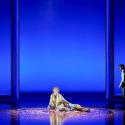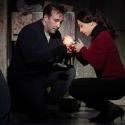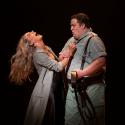The beautiful gardens of Garsington Manor might seem an ideal setting for Britten’s A Midsummer Night’s Dream, with its ilex groves, its miniature forests of pyramid yew, and its paths overhung (o’er-canopied?) with climbing roses. So it’s a mild shock to confront on the actual stage what looks like a huge attic store-room littered with beds, chucked in at all angles, a few lamps, various items of bric-à-brac, and, upstage centre, a large C. S. Lewis-style wardrobe through which, in due course, characters enter and exit.
Bed admittedly is iconic in the Dream, a work in which half the cast fall asleep at one time or another. In Daniel Slater’s production even Puck starts off in bed and is rousted out by fairies in the shape of a gang of small boys dressed up as soldiers, sailors and pilots. And this is the starting-point for a reading that treats the dream in question as a process of self-discovery, growing-up, emotional maturation. The Athenians themselves are overgrown boys and girls in school uniform, which they gradually shed. Only the presumably immortal Oberon and Tytania, and the mechanicals – for whom self-discovery is sixpence a day for life – are adults (of a kind) from start to finish.
Puck is turned from a glib-talking gymnast into a tongue-tied Beckett tramp
The idea is brilliantly effective and would be still more so, I suppose, in a theatre where the light of day could be shut out. At Garsington, with its open-sided, translucent-ceilinged marquee theatre, the nocturnal snorings and slitherings of Britten’s incomparable score are rather demystified by the sunlit purlieus of six o’clock on a June evening. The music, Francis O’Connor’s designs, and especially the lighting by Bruno Poet, all come into their own only after the long interval, ironically as dawn approaches onstage, in a truly magical ending with the lamps lit and the woodland carpets rolled away to create the opera’s one strictly indoor setting (for Theseus’s post-nuptials) and a stage for Pyramus and Thisby.
In choreography, too, there is some small loss. At the core of the production, Puck, with his acrobatic trumpet and drum accompaniment, is turned from a glib-talking gymnast into a tongue-tied Beckett tramp, error-prone not because over-hasty but because slow-witted. Richard Durden makes this convincing enough, but it slows things down more generally; and in the same way the fairies, their wings clipped, hover rather than flit, while singing with irresistible charm. Slater best achieves movement with his helter-skelter slide for the more magical entrances stage left (including the conductor’s for his curtain call), and in the Pyramus play and bergamask – impossibly stupid and overplayed as always but fun because a release from the toils of magic.
Unorthodox the setting and the action, but the music, in the experienced hands of Steuart Bedford, brings few surprises – agreeable or disagreeable. Though not always quite as fleet as the master’s own performance, it’s very much the score rendered audible, exquisitely played, attentive to stage and singers. This latter can be very necessary, not least because of Britten’s vocal predilections. Rebecca Bottone’s Tytania – bright and toppy – can ride anything in the pit, but the countertenor Oberon, James Laing, is less forward, though a stylish, intelligent performer, and unexpectedly moving when he assumes a Christ-like concern for mortal agony after the last of Puck’s bunglings. The poor manipulated lovers are a well-balanced team, wittily directed, and without undue slapstick. For Britten, perhaps significantly, the soprano was the sexually assertive Helena, sparklingly sung here by the girlish Katherine Manley, the mezzo the more stable Hermia, here Anna Stéphany – contained and dependable, exactly right. Their oft-confused squires, Andrew Staples (Lysander) and George von Bergen (Demetrius) are likewise excellent.
The mechanicals, as ever, test the director’s inventive powers. I like very much Jonathan Best’s studious, besuited Quince, the petite Pascal Charbonneau as Flute (and a worryingly attractive Thisby), and the utterly un-petite Sion Goronwy as Snug. They are well supported by Mark Wilde and Robert Gildon. But by some way the star of the show is Neal Davies’s Bottom, more bank manager than weaver, vocally authoritative, consistently funny however ghastly the jokes.By comparison Conal Coad’s Theseus and Patricia Orr’s Hippolyta are a disappointment, partly because mildly satirised, at that point in the story when sanity should speak. This Theseus is a stout and elderly admiral, the apotheosis, perhaps, of the grown-up, and questionable in his motives. Hippolyta, for her part, is clearly marrying him for what he’ll leave her.
It may be, though, that sanity is always suspect in this charmed world, if not, one hopes, in the equally magical environment of Garsington itself, on show here, sadly, for the last time before next year’s move to Wormsley. The company need three million to keep afloat. Like the mechanicals, they deserve it.
- A Midsummer Night’s Dream continues at Garsington until 2 July.















Add comment